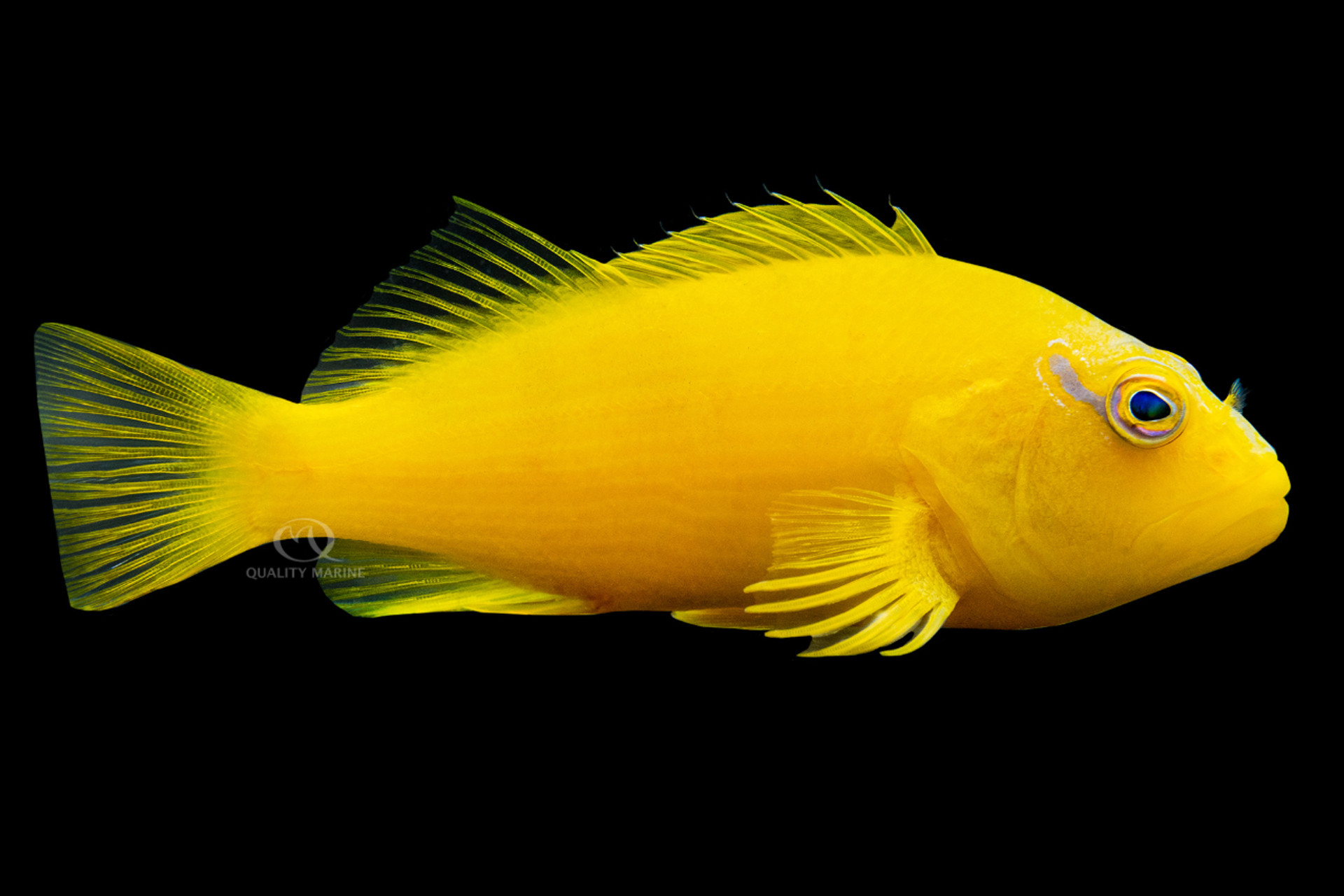All That Glitters Is a Hawkfish?

All that glitters is not always gold. Sometimes, it's a Hawkfish, and this is one of those times. More specifically, the Golden Hawkfish, sometimes also called the Blue Line Yellow Hawkfish, and less still, the Banana Hawkfish. Scientifically, we know it as Paracirrhites xanthus. Xanthus for the gold, Paracirrhites for the little curl above their eye, which all the Hawkfish in this genus have. The Golden Hawkfish is one of the rarest in the aquarium keeping hobby!
Golden Hawkfish are splendid aquarium inhabitants, with some very interesting behavior. They lack a swim bladder and so will sink if they stop swimming. This allows them to perch on things like a bird landing a wire, but this is more like a fish, landing on a rock. They'll pick a high spot in the tank and watch over the whole thing on the lookout for snacks. This lack of bladder means they can descend quickly down onto their unwitting prey. They're super interesting to watch, and with the golden color, they're going to stick out for real!
In the wild, they'd use this behavior to ambush all sorts of small inverts and fish. Golden Hawks do this in the aquarium too if allowed the opportunity. This open menu lifestyle means they're willing to eat a lot of different food too. In house we feed them Gamma Mysis, Brine Plus Spirulina, Brine Plus Omega 3, Bloodworms, Krill Pacifica, Krill Superba, along with Chopped Mussel and Chopped Prawn. They can easily be taught to take pelletized foods like the Nutramar Complete. They'll also not hesitate to eat any fish or inverts that are small enough to take down. Your larger shelled inverts like snails and hermits are pretty safe, but any really small fish or invertebrates like Perclimenes genus shrimp are in danger. They'll love the opportunity to have some live food as well, if your local LFS offers it. We feed them twice a day and this is plenty. Larger adults could be fed once per day if they got a big enough meal.
Other than diminutive tankmates being potential food, Golden Hawkfish can be kept with a wide variety of fish. The one other thing you'll want to avoid is other Hawkfish, or fish that look / act like other Hawkfish like Blennies. Good tankmates could include a wide variety of Damsels, Cardinals, Clowns, Dottybacks, Tangs, Angels, Wrasses and community friendly Triggerfish like Bluethroats. You've got plenty of choices. Fish that are super timid might get bullied / scared into hiding. The Hawkfish diet means they are almost always reef safe with a caveat. They're not going to eat your corals, but they are going to perch on them. Which shouldn't be a problem, unless their favorite spot to sit is atop a coral that doesn't like to be sat on.
There isn't any specific water chemistry needs with Golden Hawkfish, as long as it is in reasonably normal parameters, (8ish pH, SG between 1.021 and 1.026 and temp in the mid to low 70s stable, and low nitrates.) They don't need that big of an aquarium even though they can get four inches long or so, they spend most of their time sitting around. A 55-gallon tank would be sufficient. This tank should feature lots of rocks for your Hawk to perch on, the more spots the better, though they will probably prefer the perches that are highest in the tank. They don't need a substrate and are good candidates for bare bottom tanks. Your display should be covered though, as they can jump out of a tank on accident. They don't mind reef intensity lighting.
Hawkfish of all kinds are super popular around here for their general hardiness, supremely good looks, and really cool swimming behaviors. In fact, we'd go so far as to say that almost all reef tanks should have a Hawk or a Blenny in it. If you've wanted a Hawkfish but were looking for something a little rarer, Paracirrhites xanthus is your choice. These are likely the least frequently seen Hawkfish in home aquariums, making them gold in more than just name. It's time, call your LFS and see if they can get your Golden Hawkfish from Quality Marine today!